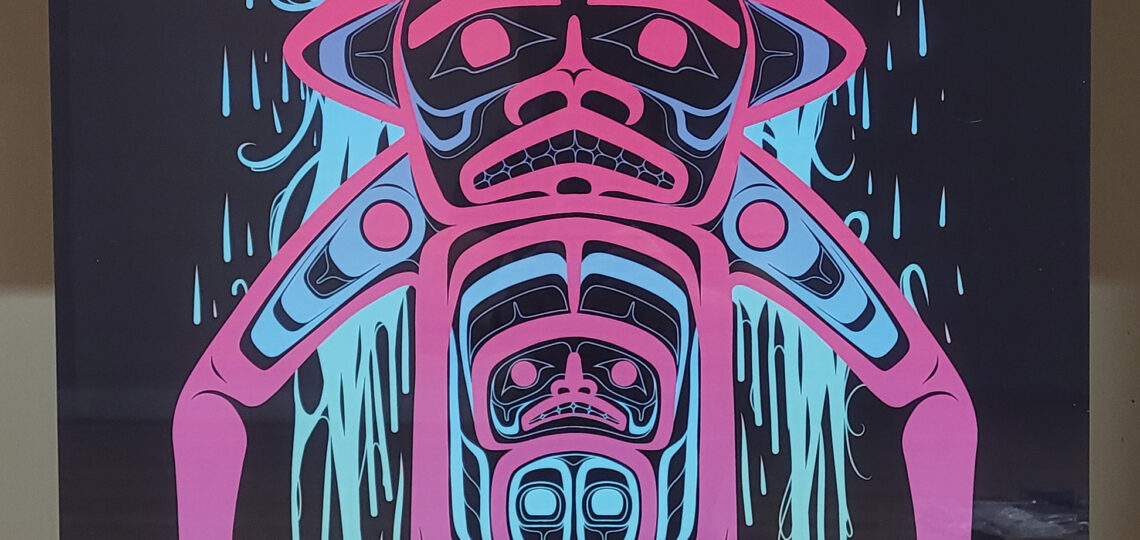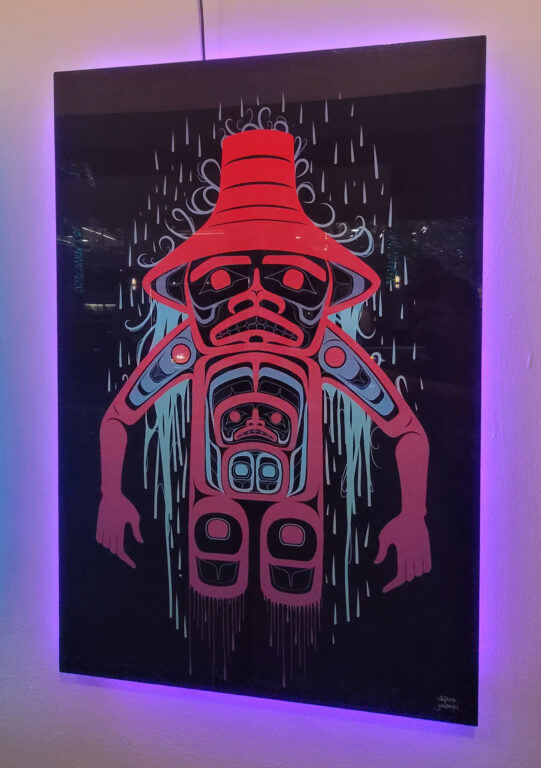
Rainkeeper: Powerful Mother’s Resilience to burden of colonialism
This is part of the Neon Series, currently installed at 5th and Pike in downtown Seattle until May, 2025 as part of a partnership with Seattle Restored. Make sure to check out the others in the series. Merchandise featuring these are available in the store. If interested in purchasing the large format with neon lighting, contact me through the my online contact form, Instagram or Facebook
Today I want to introduce you to “Rainkeeper.” This artwork isn’t just about rain; it’s about resilience, about the unbreakable spirit of the Tlingit people, and about the intimate relationship between a community and the forces of nature. This piece is a reflection on the collective strength that comes from enduring and overcoming great challenges.
In Southeast Alaska, rain is more than just a weather pattern; it’s a constant companion, a vital force that shapes the lives, the stories, and the very soul of the Tlingit people. It’s a part of their cultural identity, deeply intertwined with their history, and it has both nurtured and challenged them throughout the generations. It’s also a metaphor for the hardships they have faced and the resilience they have had to cultivate to endure. This is what “Rainkeeper” captures: the spirit of perseverance in the face of constant challenges and an understanding that we are all connected to each other and to the world around us.

Rainkeeper installed with neon lighting
A Figure Veiled in Rain: A Visual Ode to Endurance
The visual composition of “Rainkeeper” is both simple and profound. The viewer is presented with an image set against a stark black background, a solitary figure veiled in rain, creating an atmosphere that is both somber and captivating. This figure is not simply an image; it’s a symbol of the Tlingit people, and their ability to endure all that life throws at them. This figure is wearing a somewhat mysterious hat, conical in shape, made of a traditional woven fabric. The hat is deeply connected to the culture and history of the Tlingit people, holding its own stories within the weave. It also shows the deep connection of the Tlingit people to the land.
The rain itself is rendered with a deep blue tone at the top, gradually transitioning to cyan near the bottom, creating a gradient that enhances the visual appeal while also symbolizing the constant, ever-present nature of rain in Southeast Alaska. It’s not just water; it is the very essence of life, a visual that is all at once life-giving, while also representing the burdens and hardships of the Tlingit people. It emphasizes the constant presence and impact of the rain, which is often a daily part of life in that area, and highlights how they have not only learned to cope with it, but to appreciate its place in the grand scheme of things. This artistic choice creates a sense of movement and fluidity, reinforcing the constant presence and impact of rain in the daily life of the Tlingit people. This isn’t just a picture of a person in the rain; it’s a depiction of the constant companion that has been with them for generations. It is a recognition that our histories are not separate from the natural world.
The figure’s outstretched arms and the cascading rain are reminiscent of how they must navigate the elements in their everyday lives. It creates a visual parallel that speaks to the burden they bear. Extended periods of heavy rain are common in Southeast Alaska, reinforcing the themes of resilience and perseverance, as it represents the need to endure difficult circumstances, while also speaking to their ability to overcome. It’s not just a symbol of struggle; it also represents their ability to rise above those struggles. It is a recognition of the fact that their strength does not come from overcoming the elements but from understanding their place within the grand scheme of the universe. It is an ode to their deep connection to the world around them.

Here the belly of the figure shows both a ancestor and a child, encompassing the concept of “Haa Shagoon”
Within the belly of the figure is another, smaller form. This other figure symbolizes either a child or an ancestral spirit, further highlighting the connection between past, present, and future. This duality in representation speaks to both the nurturing aspect of motherhood and the enduring presence of ancestral spirits, guiding and supporting the living. It reminds us that we are all connected, and that we do not exist in a vacuum but in a grand tapestry of life that has connections to all those who came before us, and will come after. It is a poignant reminder that we do not exist in isolation.
Cultural Significance: The Language of Heritage
The hat adorned with four potlatch rings is a significant detail, signifying the high status of this individual within Tlingit society. Potlatches are ceremonial gatherings where clans build wealth over years to give away to their guests, embodying the values of generosity and community. Each ring on the hat represents a significant potlatch held by the clan. Thus, one could interpret this as a high-status woman who has built up her wealth and given it away four times in her lifetime, a true symbol of the giving and gracious spirit that is a fundamental part of the culture. This gives us a deeper understanding of the figure as not just someone who endures but also as someone who gives freely. It shows us that it is not only our ability to endure that makes us strong but also our ability to be compassionate and caring.

Notice the potlatch rings representing prestige of the individual as the rain bounces off the hat
The conical hat is also a traditional weaving, and its intricate designs hold cultural significance, with each element holding its own set of stories and meanings, passed down through generations. These patterns are not merely decorative, but are symbolic representations of the history of the Tlingit people, and the deep connection that they have with their land.
The figure also features a labret piercing, a common traditional cultural marker for women of high status. This detail emphasizes the feminine essence of the Tlingit spirit. It is also a symbol of her maturity, as it is an indication that she has passed through puberty. This is a reminder of the importance that is placed on the roles that women play within Tlingit culture and their capacity to endure and to give back to their communities.

Notice the woman’s labret piercing in her lip, this helps identify the figure as a woman
The Resilience Within: More Than Just a Symbol
“Rainkeeper” isn’t just a depiction of an individual’s strength; it’s a tribute to the collective endurance of the Tlingit people. It honors those who came before us and celebrates the resilience that allows us to continue our traditions today, a spirit that is fundamental to the human experience. The cascading rain is meant to reflect the weight of history and the strength that is required to overcome it, and to highlight the ongoing struggles that Indigenous communities continue to face. It acknowledges that all of our individual struggles are also a part of a larger story.
The piece is deeply connected to the historical challenges of colonialism, and how the Tlingit people and their children were forced to move from their traditional homelands and endure significant hardships. Yet, it is through their resilience and their deep love for their traditions that they have continued to survive, and thrive, throughout those challenges. It is their love for their cultures that has carried them through some of the darkest periods of history. This piece is not only an acknowledgement of their suffering but a recognition of their ability to transcend it.
The cascading rain also symbolizes the weight of colonialism, a burden that many ancestors had to bear as they were displaced from their lands. This is an acknowledgment of that weight while also celebrating the resilience and strength that is required to carry on in the face of injustice. Despite these challenges, they persevered with the mindset that their strength was not just for themselves, but also for their children and future generations. They were not merely surviving; they were cultivating a love for their culture that would not only carry them through difficult times but would also be a guiding light to those who came after. This piece is a tribute to their endurance, reminding us that it is due to their resilience that we can continue to live and uphold our traditions today. This is a recognition of their ability to endure despite the many difficulties that they have had to overcome.

rain cascading off the woman almost forming hair and a dance skirt
An Invitation to Feel and Reflect
“Rainkeeper” is designed to evoke a sense of quiet strength. It captures the emotional landscape of the Tlingit people, their deep connection to their ancestors and to the natural world. This is a piece that is meant to evoke strong emotions. The rain, while often associated with gloom, is used in this piece to symbolize the weight of both history and the ongoing challenges that they face, while also acknowledging the importance of tradition in the face of those struggles.
This piece invites us to look beyond the surface and to find the deeper meaning that it holds within it. It seeks to open our hearts to the ongoing struggles that indigenous peoples face, and it reminds us to celebrate the strength that they show throughout their hardships.
Final Thoughts: A Beacon of Hope
Creating “Rainkeeper” was an intimate experience, and I hope it serves as a beacon of hope and a reminder of the enduring nature of the human spirit. It’s not just a depiction of an individual’s strength, it’s a celebration of the collective power of a culture to persevere through adversity, while also acknowledging that we all have a part to play in cultivating a better world. I hope that it inspires you to reflect on your own lives, and on the things that you have endured, and that it brings you a sense of calm and purpose to those who see it. It is also a challenge to us all, to find empathy in our hearts for those who have faced hardships that we can not even begin to imagine.
I hope it will resonate with you and that it will create an awareness that will motivate you to act and to become a better friend to all those around you.
Previous Art Description: Neon Series: Confluence
Next Art Description: Neon Series: Shaman Mask
Head back to the Neon Series Overview Blog
Check out the awesome Neon Series merchandise available in the store


